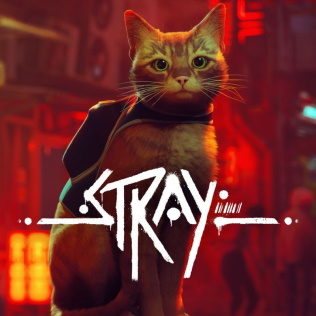Stray: I’m a cat :3

Stray, the debut game by the French developer Bluetwelve Studio, is an atmospherically smooth game that I enjoyed inhabiting and strolling through. This is the summer 2022 “cat game” that touched the consciousness of even those who don’t play video games.
The player is a stray cat who gets separated from its herd and has to find its way out of a dark but mostly colourfully gentle cyberpunk city.
Being a cat and doing cat stuff is the attractive core of the game and seems to have been the big draw from the start. The development blog , published since 2015, starts out specifically from the idea someone had of a cat on an adventure.
By indie studio standards, the cat is animated smoothly and believably enough. I like how the game portrays the essence of a cat’s life and agency through a silly, almost self-conscious anthropocentric lens. The cat is represented as a mischievous, unerringly agile creature that indignantly paws objects off tables, goes where it pleases, and cannot be kept back by any obstacles. As a cat, you can meow, go on zoomies, walk elegantly on narrow railings, drink from puddles, and scratch sofas.
This game is, I should mention, a good choice for those who rarely play games, because the controls are quite forgiving. Especially the cat’s jump has been purposefully designed to be very accessible. Unlike in most platformers, in Stray you don’t have to precisely aim and time your jump to successfully land where you meant to. In this game you are also rarely under time pressure; only in a few action sequences, which I personally did not find very demanding.
I came here to leap, not to read
As a story, getting lost and finding your way is a functional framework, but I didn’t end up really caring about all the exposition the game was dumping on me. Early in the game, the cat finds a robot called B-12, which allows the cat to talk to other robots, the only inhabitants of the city.
Stray is such a visual and atmospherically sensitive game that B-12 and the dialog of the robots relayed by it felt like a story-telling crutch. I would have wanted the game to explain its world and carry its story along more organically and suggestively, in a more cat-centric way. The moments I had to spend reading the uninspired things the robots had to say, I would have rather spent on what the game expressed so uniquely, inhabiting cathood.
(Perhaps I would have felt differently, if the robots had been voice-acted, but that would have of course blown the game’s budget out of proportion. Textual dialog is much cheaper to get translated to multiple languages than dozens or hundreds of voice-acted lines.)
In addition, the world is ultimately quite empty and sterile. While the graphical aesthetic, music and sound design are impeccable and the city is remarkably detailed, somehow there are still surprisingly few things to discover in it. This kind of game would absolutely benefit from a larger amount of little nooks and crannies to explore, hidden levers to pull and silly environmental jokes to get.
I would have liked to be all in on experiencing cathood. To feel accomplished squeezing through impossibly tight spaces, conquer the highest spots, slip away unnoticed, and satisfy curiousity. But the game didn’t trust its foundational idea enough; instead it wanted to play it safe by supporting it with a disappointingly traditional script and expositional narrative. To me it mostly feels like repeatedly breaking the immersion, but maybe I’m wrong. Maybe play testing showed that this is the better way.